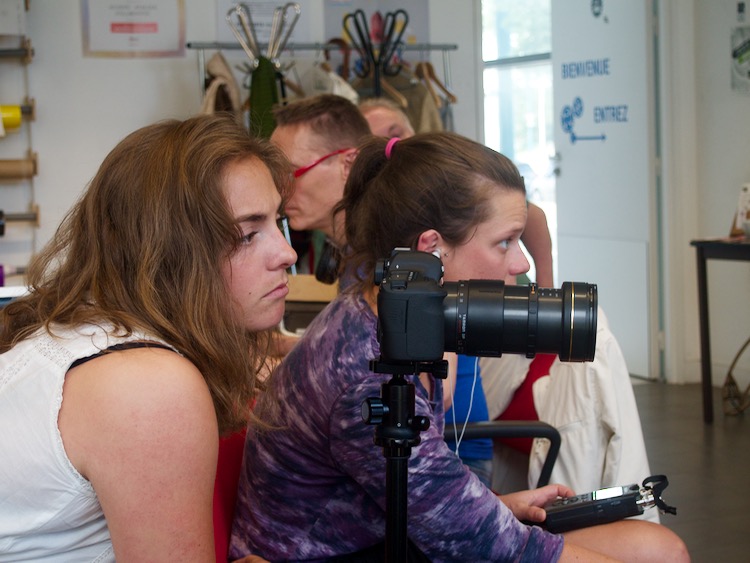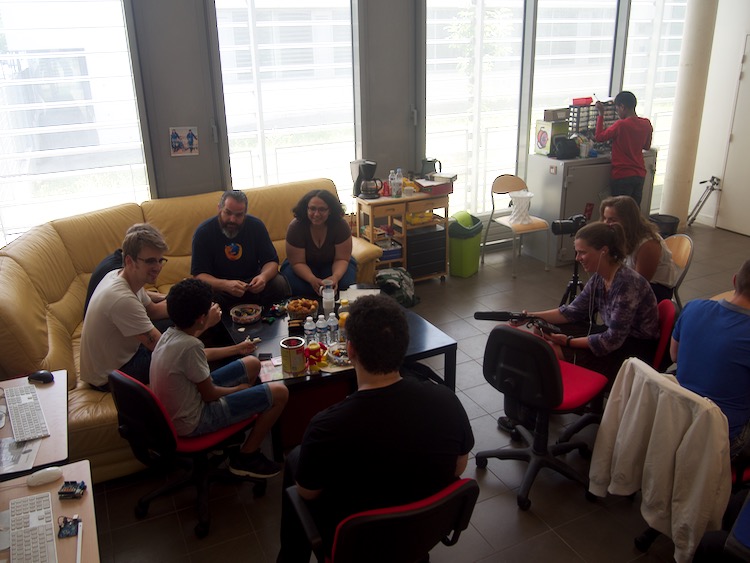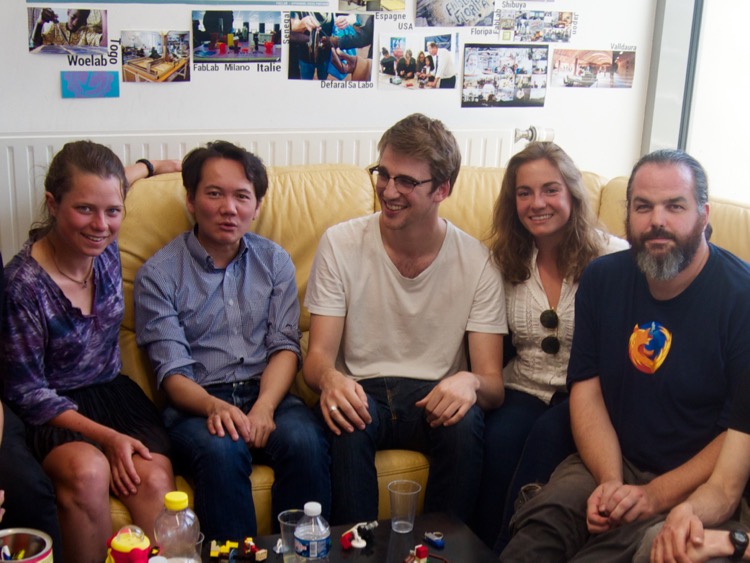Two Americans’ bike tour of European labs
Published 29 June 2015 by Nicolas Barrial
Miriam Engle and Madison Worthy left Copenhagen on bicycles at the end of April to produce a documentary on European fablabs. After Denmark, Germany, Holland and Belgium, the two Americans were at the Gennevilliers Faclab on June 19th. Meeting.
Madison Worthy and Miriam Engle arrived in Paris on bicycles on June 18th, after a stop-over in Reims and coming from Belgium. On the following afternoon, the two Americans answered the multitude of questions from makers who came to welcome them at the Gennevilliers Faclab. Two months already since they started their tour of European fablabs, an idea born in Colorado where the two Americans met.
Having visited two dozen fablabs, their long haul will end at the end of July in Barcelona. Madison and Miriam will then return to the United States to take part in the Boston Fab11 and finish the filming of their documentary named Self-Made: The Story of Creative Communities Self-Made: The Story of Creative Communities,that should be released early 2016.
“Self-Made: The Story of Creative Communities”, presentation of the documentary:
The Faclab through the lens of the Americans
The Gennevilliers Faclab, attached to the University of Cergy-Pontoise, is open to all, including teachers looking to back up their educational methods with digital fabrications. The subject interests Miriam and Madison who gather around ten people to film a two-hour debate, having looked around the place.
Among the questions addressed: what 21st century do we want to create? Which role could fablabs play in education and industry? How does one turn the maker movement into a general public movement without corrupting it? Subjects well known to the people attending the debate, among which we recognise Olivier Gendrin, former fabmanager of the Faclab, Antonin Fournier from the Faclab or still Andy Kwok, from the Petit Fablab de Paris.


The presence of Sofia Manseri, town councillor of Gennevilliers in charge of feminism issues, focussed the discussion on the place of women in fablabs. A heated debate we will no doubt rediscover in the documentary. Meanwhile, Makery also held the microphone to get feedback from Madison and Miriam on their trip.
Why this European bike tour of European fablabs?
Miriam Engle : After studying literature, I met Madison in Colorado in 2014 when we were ski instructors. Madison had worked in Boulder (Colorado) for Indigo, a technology education program, and had approached the maker movement and fablabs. In January she proposed that we go on a bicycle trip to Europe to document the phenomenon. We left our jobs headed straight for Europe, to Copenhagen.
Why Europe?
Madison Worthy :The number of fablabs is very important in Europe. I believe it is linked to the crisis and a certain urgency. In the United-States, we remain in a comfortable economy based on oil. In Europe, people are ready to take risks. During my research, I noticed that in Italy where we visited fablabs before starting our tour, there was a lot of unemployment and fablabs were emerging everywhere. The reason is negative but the results are positive; it gives the unemployed a place to work, do things and feel useful.
“The first ten years of the Fab culture were focused on education, inspiring people to acquire new skills and clearing up the fear of technology. Now that we have the knowledge and the access, we can improve our overall standard of living. And we need no one’s permission.”
Miriam Engle
Madison : In Holland, we became aware that they based everything on education, they are making a big effort countrywide to incorporate fablabs into libraries. We have never seen that anywhere. I was really jealous: in the United-States, you have to fight to have the right to become an educated person. In Europe, it seems to be the normal course of action to go to college and choose your path in life. And the fablabs also favour this education, allowing individuals to pursue their ideas, projects.
How did you fund the adventure?
Miriam : We carried out crowdfunding campaign so that people would feel involved in our project but we mostly invested our own savings. The documentary allows us to define which types of resources emerge from the network; people welcome us, some people travel with us, others want to discuss the future of fablabs or technology. It is kind of unique not to have a story to tell in advance, our dynamic is exponential.
Madison : We were lucky. In lots of places where we went we were offered lodging, sometimes a garden to set up camp! Since we left, we only paid once for accommodation. We used the couch surfers community. Sometimes, they would tell us about a fablab in the middle of nowhere. But we mostly converted loads of people to the world of fablabs.
Which fablabs impressed you the most?
Madison : The Kaas Fabriek in Holland. We got there around 10pm, exhausted from our longest bike ride, more than 100 km. And there, about twenty people were bustling about; fathers were working with their sons, women were cutting cookies with a laser cutter. It truly is a community with an organic growth. The whole fablab is built with containers, and therefore, no rent, no address. We took picture until 1am and finally slept there.
Miriam : We were also impressed by the Ammersfoort Fablab, still in Holland. They do a great job building a community that does not seek to make profits but encourages people to innovate. They are very successful and have an enormous amount of ongoing projects, including environmentally friendly projects. They have a very big garden outside the fablab where a person is building solar-powered boats. And on a neighbouring rooftop, urban beehives pollinate the garden. It is a whole ecosystem. We are also very curious to see Barcelona. It is said that they want a fablab in each district. We want to know if they will manage to maintain an authenticity approach.
Do you bring back keepsakes from each lab and did you use labs to repair things?
Miriam : We were lucky, no breakages on the bikes, German second-hand bikes renovated in Copenhagen. We just had them looked over regularly in the workshops. At the beginning we took away objects each time, but after a while, they became heavy, so we gave them away at the following stop-over. It became a ritual. The only underlying theme was a speaker that we had fixed on a bike to hear music. It had been designed by the Denmark Fablab, a mobile fablab, but it didn’t work very well outside. It was the Kaas Fabriek in Holland that repaired it for us. But we got tired of carrying it around, so we finally gave it to a lab in Belgium. They were glad to receive this object, fruit of a European effort!
Who will edit the documentary and how will it be broadcast?
Madison : I will. I was offered help for post-production but the idea is to do it alone, self-made! And besides, we made a deal with Futuremag,for a documentary series.
Miriam : We have terabytes of data. Everything will be open source, we want people to use our resources. We might do a paying director’s cut to recover a bit of the funding.
Do you intend to pursue the adventure on other continents?
Miriam : Yes of course if we have the funding! I will have to go back to work at the end of this trip. I will probably go back to the ski instructorship as soon as November. Afterwards, I intend to write and become a “nomadism professional”.
Madison : As for me, I intend to carve a place for myself in the fablab environment. An opportunity awaits me in a school in Denmark. I want to continue to educate, pass on. I have a particular interest in biohacking, I intend to do research on mycelium mushrooms. And produce my own furniture for my new apartment!

With no real route plan, except for countries visited, the two Americans travel according to the opportunities and recommendations they get at each stop-over. France does not escape their insight: after Paris, they are off to Kelle Fabrik in Dijon, before meeting with several members of fablabs in Franche-Comté and the newvine fablab in Savigny-les-Beaune.
